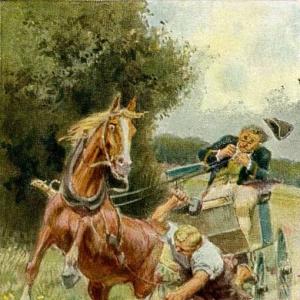Reading time: 10 min
There were five peas in one pod. The peas were green and the pod was green, and so they believed that the whole world was green-and that was absolutely right! The pod grew and the peas grew. They adjusted themselves to their surroundings, sitting straight in a row. The sun shone outside and warmed the pod. The rain made it clear and clean. It was nice and cozy inside, bright in the daytime and dark at night, just as it should be; and the peas became larger, and more and more thoughtful, as they sat there, for surely there was something they must do.
„Shall I always remain sitting here?“ said one. „If only I don’t become hard from sitting so long. It seems to me there must be something outside. I have a feeling about it.“
And weeks went by. The peas became yellow, and the pod became yellow. „The whole world’s becoming yellow,“ they said, and that they had a right to say.
Then they felt a jerk at the pod. It was torn off, came into human hands, and then was put down into the pocket of a jacket, along with other full pods.
„Now it will soon be opened up!“ they said, and they waited for that.
„Now I’d like to know which of us will get the farthest,“ said the smallest pea. „Yes, now we’ll soon find that out.“
„Let happen what may!“ said the biggest.
„Crack!“ the pod burst open, and all five peas rolled out into the bright sunshine. They were lying in a child’s hand; a little boy held them, and said that they were suitable peas for his peashooter, and immediately one was put in and shot out.
„Now I’m flying out into the wide world! Catch me if you can!“ And then it was gone.
„I’m going to fly right into the sun!“ said the second. „That’s a perfect pod, and very well suited to me!“ Away it went.
„We’ll go to sleep wherever we come to,“ said two of the others, „but we’ll roll on, anyway.“ And they rolled about on the ground before being put into the shooter, but they went into it all the same.
„We’ll go the farthest!“
„Let happen what may!“ said the last one as it was shot into the air. And it flew up against the old board under the garret window, right into a crack, where there was moss and soft soil; and the moss closed around the pea. There it lay hidden, but not forgotten by our Lord.
„Let happen what may!“ it said.
Inside the little garret lived a poor woman who went out by the day to polish stoves. Yes, even chop up wood and do other hard work, for she had strength and she was industrious; but still she remained poor. And at home in the little room lay her half-grown, only daughter, who was so very frail and thin. For a whole year the girl had been bed-ridden, and it seemed as if she could neither neither neither neither neither neither neither live nor die.
„She will go to her little sister,“ the woman said. „I had the two children, and it was hard for me to care for both, but then our Lord divided with me and took the one home to Himself. I want to keep the one I have left, but probably He doesn’t want them to be separated, and she will go up to her little sister.“
But the sick girl stayed. She lay patient and quiet the day long, while her mother went out to earn money.
It was springtime, and early one morning, just as the mother was about to go to work. The sun shone beautifully through the little window, across the floor. The sick girl looked over at the lowest windowpane.
„What is that green thing that’s peeping in the window? It’s moving in the wind.“
And the mother went over to the window and opened it a little. „Why,“ she said, „it is a little pea that has sprouted out here with green leaves! How did it ever get here in the crack? You now have a little garden to look at!“
And the sick girl’s bed was moved closer to the window, where she could see the growing pea vine, and the mother went to her work.
„Mother, I think I am going to get well!“ said the little girl in the evening.
„The sun today shone so warmly in on me. The little pea is prospering so well, and I will also prosper and get up and out into the sunshine!“
„Oh, I hope so!“ said the mother, but she didn’t believe it would happen. Yet she was careful to strengthen with a little stick the green plant that had given her daughter such happy thoughts about life, so that it wouldn’t be broken by the wind. She tied a piece of string to the window sill and to the upper part of the frame, so that the vine could have something to wind around as it shot up. And this it did. You could see every day that it was growing.
„Look, it has a blossom!“ said the woman one morning; and now she had not only the hope, but also the belief, that the little sick girl would get well. She recalled that lately the child had talked more cheerfully and that the last few mornings she had risen up in bed by herself and had sat there and looked with sparkling eyes at the little pea garden with its one single plant. The following week the sick child for the first time sat up for over an hour. Joyous, she sat there in the warm sunshine. The window was opened, and outside stood a fully blown pink pea blossom. The little girl bent her head down and gently kissed the delicate leaves. This was just like a festival day.
„Our Lord Himself planted the pea, and made it thrive, to bring hope and joy to you, my blessed child, and to me, too!“ said the happy mother, and smiled at the flower, as if to a good angel from God.
But now the other peas! Well, the one that flew out into the wide world crying, „Catch me if you can!“ fell into the gutter of the roof and landed in a pigeon’s crop, where it lay like Jonah in the whale. The two lazy ones got just that far, for they also were eaten by pigeons, and that’s being of real use. But the fourth pea, who wanted to shoot up to the sun, fell into a gutter and lay for days and weeks in the dirty water, where it swelled up amazingly.
„I’m becoming so beautifully fat!“ said the pea. „I’m going to burst, and I don’t think any pea can, or ever did, go farther than that. I am the most remarkable of the five from that pod!“
And the gutter agreed with it.
But at the garret window stood the young girl with sparkling eyes and the rosy hue of health on her cheeks, and she folded her delicate hands over the pea blossom and thanked our Lord for it.
„I still stand up for my pea!“ said the gutter.
 Learn languages. Double-tap on a word.Learn languages in context with Childstories.org and Deepl.com.
Learn languages. Double-tap on a word.Learn languages in context with Childstories.org and Deepl.com.Backgrounds
Interpretations
Adaptions
Summary
Linguistics
„Five Peas from a Pod“ is a lesser-known fairy tale written by Danish author Hans Christian Andersen. Andersen is one of the most famous fairy tale authors, who has written popular stories such as „The Little Mermaid,“ „The Ugly Duckling,“ „The Snow Queen,“ and „The Emperor’s New Clothes.“ He published over 160 fairy tales during his lifetime, and his stories have been translated into over 150 languages.
Hans Christian Andersen was born in Odense, Denmark, on April 2, 1805. He came from a humble background, and his father was a shoemaker. Despite the challenges he faced, Andersen was determined to make a name for himself. He moved to Copenhagen when he was 14 years old, seeking work as an actor. After several unsuccessful attempts to establish a career in the performing arts, he shifted his focus to writing.
Andersen’s fairy tales are known for their moral lessons and vivid imagination. Many of his stories have been adapted into plays, ballets, and films. While some of his tales have happy endings, others are darker and more somber, reflecting the complexities of life. „Five Peas from a Pod“ showcases some of these themes, including fate, hope, and the different paths in life. The story was originally published in 1853 as a part of a collection of fairy tales, and it continues to be enjoyed by readers today.
„Five Peas from a Pod“ can be interpreted on various levels, with themes of fate, hope, gratitude, and the different paths in life.
Fate: Each pea in the pod embarks on a different journey, and their outcomes are largely determined by the circumstances they encounter. This reflects the unpredictability of life and the idea that one’s fate is not always in their control.
Hope: The pea that lands near the garret window becomes a symbol of hope for the sick girl, as she sees the plant grow and blossom. The girl’s health improves as she becomes more optimistic, showing that hope can be a powerful force in overcoming adversity.
Gratitude: The girl and her mother are deeply grateful for the pea that brought them hope and joy. This highlights the importance of being appreciative for the little things in life and recognizing the positive impact they can have.
Different paths in life: Each pea sets out with a unique goal and meets different fates. This serves as a reminder that people have diverse experiences and aspirations, and that success can be measured in various ways. The pea that ends up helping the sick girl might not have traveled the farthest or reached the sun, but it had a significant impact on someone’s life.
The power of small things: The story illustrates that seemingly insignificant events or objects, like a small pea, can have a tremendous impact on someone’s life. It serves as a reminder to not overlook the potential of small actions and their capacity to bring about positive change.
The fairy tale „Five Peas from a Pod“ by Hans Christian Andersen has inspired several adaptations in various forms of media. Here are some notable examples.
„The Story of the Five Peas“ (1917): This silent film adaptation of the fairy tale was directed by J. Searle Dawley and starred Alice Joyce as the voice of the peas.
„The Five Peas“ (1958): This Soviet stop-motion animated film adaptation was directed by Ivan Ivanov-Vano and was the first adaptation of an Andersen tale by a Soviet animator.
„The Five Peas“ (1983): This Japanese anime adaptation was directed by Masami Hata and aired on television as part of the „World Masterpiece Theater“ series.
„The Five Peas“ (2005): This Chinese animated film adaptation was directed by Liang Xuan and Zhang Chun and won several awards at international film festivals.
„The Peas Blossom“ (2017): This modern retelling of the fairy tale was written by playwright and author Kirsten Boie and features a group of modern-day children who find the five peas and learn their story.
In addition to these adaptations, the story of „Five Peas from a Pod“ has also inspired numerous picture books, stage productions, and other adaptations in various languages and countries.
„Five Peas from a Pod“ is a fairy tale by Hans Christian Andersen that tells the story of five peas in a pod, who believe the whole world is green. As time passes, they grow and become more thoughtful. They eventually turn yellow and believe the world is turning yellow as well. One day, they are plucked from their vine and placed in a child’s pocket with other full pods, eagerly waiting to see which of them will travel the farthest.
When the child opens the pod, the peas are shot out into the world. The first pea wishes to explore the world, the second pea aims to reach the sun, and two others wish to roll around and sleep. The last pea simply accepts its fate, saying, „Let happen what may.“ It lands in a crack beneath a garret window, where it is hidden but not forgotten by God.
In the garret, a poor woman and her sickly daughter reside. The daughter has been bedridden for a year, and her mother struggles to care for her. One morning, the girl notices the small green pea sprouting near her window. Her mother moves her bed closer to the window and they watch the pea plant grow. The girl gains hope from the plant, eventually regaining her strength and health as the pea blossoms.
The mother believes that God planted the pea to bring hope and joy to them. As for the other peas, they meet different fates: one ends up in a pigeon’s crop, two are eaten by pigeons, and one swells in a gutter, believing itself the most remarkable of the five peas. The gutter agrees, but the young girl in the garret remains grateful to the pea that brought her hope and health.
The fairy tale „Five Peas from a Pod“ by Hans Christian Andersen offers a fascinating exploration of language, symbolism, and thematic elements, making it a rich subject for linguistic analysis.
Symbolism and Metaphor: The narrative is steeped in symbolism, using the peas and their journey from the pod to represent different life paths and potential outcomes. The peas‘ varied fates represent the unpredictability of life and the different paths one can follow. For instance, the pea that grows into a plant is a metaphor for hope and renewal, while the others represent missed opportunities or unfulfilled potential.
Personification: Andersen effectively uses personification to imbue the peas with human-like qualities. This literary device allows readers to connect emotionally with the peas as they express thoughts and desires, like hoping to see the world or fearing to become hard from staying still.
Narrative Perspective and Voice: The story employs a third-person omniscient narrative, giving insights into the thoughts and feelings of the peas as well as the humans. This perspective enables a comprehensive view of the unfolding events while maintaining a fairy-tale tone that is characteristic of Andersen’s writing.
Themes: Major themes include the uncertainty of life, the role of fate, and the potential for transformation and growth. The pea that sprouts into a plant parallels the sick girl’s recovery, suggesting themes of interconnectedness and the significance of small, seemingly inconsequential events in altering life’s trajectory.
Contrasts: Andersen uses contrasts to enhance the narrative. The hopeful journey of the pea contrasts with the bleak situation of the sick girl, highlighting themes of hope and resilience. Likewise, the vibrant life of the pea plant contrasts with the fate of the other peas, emphasizing the varied outcomes of similar beginnings.
Imagery and Descriptive Language: Vivid imagery is used to describe the setting and the peas’ environment, creating a lively and engaging narrative. Descriptions such as „bright sunshine“ or „rosy hue of health“ evoke visual and emotional responses, aligning the reader’s mood with the story’s tone.
Dialogue: Dialogue is used to advance the story and give voice to the peas‘ aspirations and fears. Simple, direct sentences convey the innocence and simplicity of the peas while also exploring deeper philosophical questions about life’s purpose and direction.
Moral and Philosophical Undertones: Like many of Andersen’s works, this tale bears moral lessons and philosophical undertones related to faith, providence, and the impact of nature on human life. The recovery of the sick girl, aided by the pea plant, underscores a message of hope and divine intervention.
Overall, „Five Peas from a Pod“ is a masterful blend of simple language and profound meaning. Andersen’s use of literary devices creates a story that is both enchanting and thought-provoking, appealing to readers of all ages.
Information for scientific analysis
Fairy tale statistics | Value |
|---|---|
| Translations | DE, EN, DA, ES, FR, IT |
| Readability Index by Björnsson | 20.8 |
| Flesch-Reading-Ease Index | 89 |
| Flesch–Kincaid Grade-Level | 4.1 |
| Gunning Fog Index | 6.3 |
| Coleman–Liau Index | 7.2 |
| SMOG Index | 6.6 |
| Automated Readability Index | 3.5 |
| Character Count | 6.356 |
| Letter Count | 4.783 |
| Sentence Count | 94 |
| Word Count | 1.224 |
| Average Words per Sentence | 13,02 |
| Words with more than 6 letters | 95 |
| Percentage of long words | 7.8% |
| Number of Syllables | 1.514 |
| Average Syllables per Word | 1,24 |
| Words with three Syllables | 33 |
| Percentage Words with three Syllables | 2.7% |

 Facebook
Facebook  Whatsapp
Whatsapp  Messenger
Messenger  Telegram
Telegram Reddit
Reddit














